from Dai Manuel: Your Lifestyle Mentor https://ift.tt/2JRMkWT
Wednesday, June 13, 2018
The Best 5 Healthy Living Tips for Amazing Dads
from Dai Manuel: Your Lifestyle Mentor https://ift.tt/2JRMkWT
How to Revive Flattened Carpet
Find out how you can make your carpet look like new without having to spend the money to replace it. Here are some easy-to-do tips for you to follow:
 Photo by Christian Chen on Unsplash
Photo by Christian Chen on Unsplash
Move your furniture regularly
Carpet pile gets flattened when heavy objects sit on it for too long, so make it a point to slightly adjust heavy furniture periodically to avoid flat spots. Either move your furniture a few inches every few weeks, or rearrange your room entirely to keep your carpet from wearing unevenly and causing flat spots. Try to create new walkways between your furniture, as high traffic can cause flattening of larger areas. When you move your furniture, lift it up entirely off the carpet instead of dragging it to avoid causing extra wear on it that may cause even more flattening. Source: HomeGuides.SFGate
Use an ice cube
To get rid of indentations and bring your carpet back to life, place a single ice cube in the indentation and allow it to melt. Once it has melted, brush the carpet fibers with your fingers to revive them. Do not use a scrub brush; this will be too abrasive and harmful to your carpet! Finish by vacuuming the area, once the carpet is fully dry. Voila! You no longer need to feel like your furniture is chained to the spot. Source: TheSpruce
Use an iron
Place a damp cloth over the indentations. Hold a hot steam iron a few inches above it to allow the moisture to work its way into the pile. Do not let the iron touch the carpet pile. Alternatively, use a hair dryer to warm the pile. While it is still warm, use a spoon, coin or the tips of a fork to gently tease the pile upright. Source: EzineArticles
Does your carpet still look worn even after trying these tips? We can help you out! Call us!
The post How to Revive Flattened Carpet appeared first on Curlys Carpet Repair.
from Curlys Carpet Repair https://ift.tt/2sZqUh1
3 Astoundingly Simple Nutrition Strategies for Athleticism
from Dai Manuel: Your Lifestyle Mentor https://ift.tt/2MnY6qo
Tuesday, June 12, 2018
Hey Pop – you’re da best!
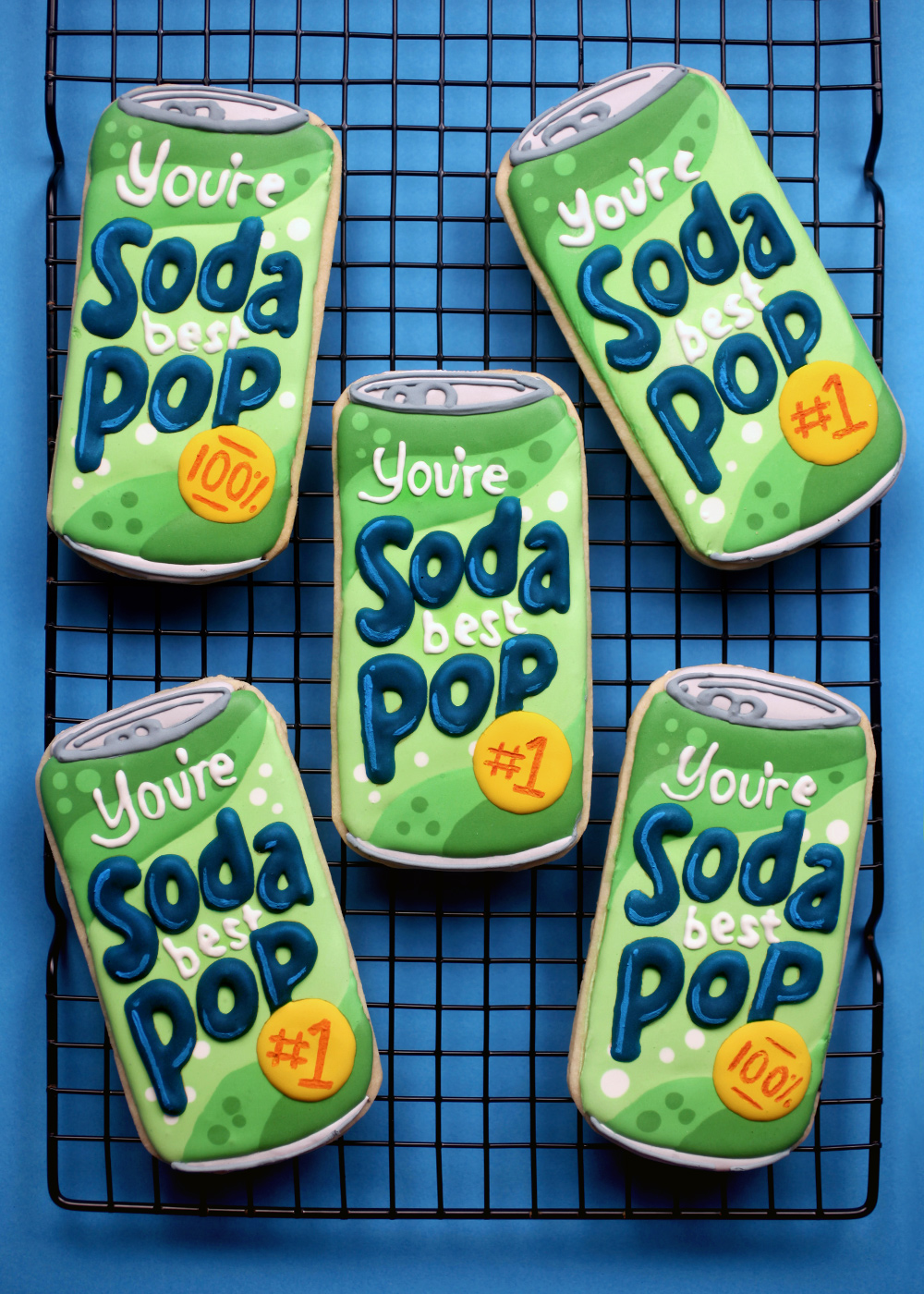
Enjoy these refreshing cookies for Father’s Day! They’re jumbo sugar cookies decorated with royal icing and they’re a fun way to tell Dad he’s the best pop around.

First off make some cookie dough. I used this Sugar Cookie Recipe from Bake at 350. It’s a keeper and I use it whenever I make sugar cookies. The recipe makes 9 of these jumbo cookies. Ten if you rolled them a little thinner.
I used this awesome rolling pin to roll out the cookie dough. A new fave I recently bought from Food52. It rolls perfectly even, quarter-inch-thick cookies. I have always used a rolling pin and added those thick rubber bands on the ends to help keep my cookie thicknesses the same, but this one is much more convenient and I love it so far.
Now, I’ll admit that these cookies are not the quickest to make because of the multiple colors and drying time needed, but I couldn’t resist trying to make them after this soda pop pun popped in my head. If you’re a cookie decorating pro, they’ll probably be a breeze for you, though. I’m not, so I made a template for my idea to make the decorating easier.
I highly recommend downloading this template for yourself if you decide to give them a go.
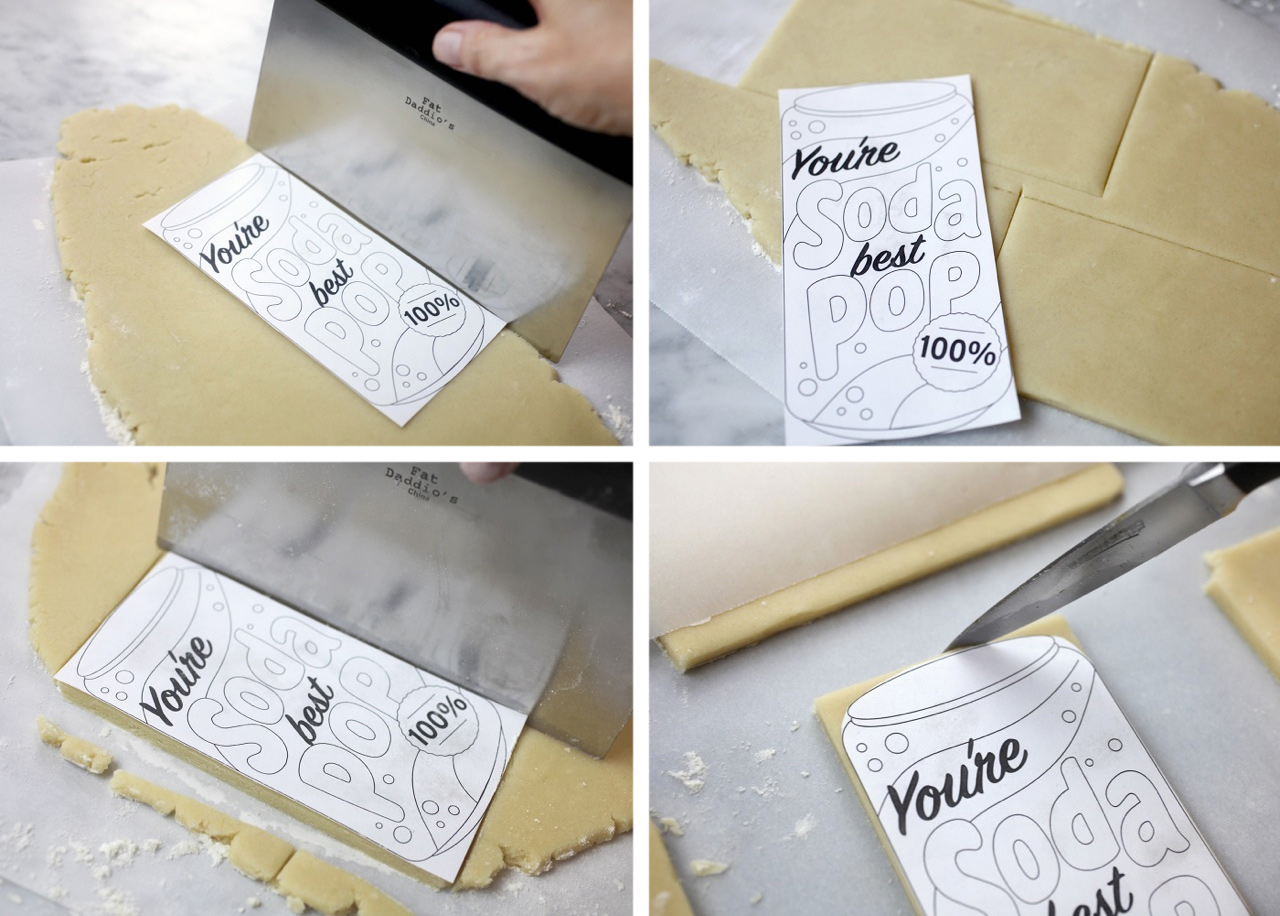
- Cut out the soda can from the paper template with scissors.
- Roll out cookie dough and use a straight edge to cut the dough into rectangular shapes based on the size of the template.
- Then cut out the corners of the can from the paper template and use a knife to cut the same corners off from the dough.
I always roll my dough on lightly floured parchment paper so I can easily transfer the cookie cut outs to a baking sheet when they are ready to go in the oven.
Bake them at 350 degrees Fahrenheit for about 15 minutes and let cool completely.
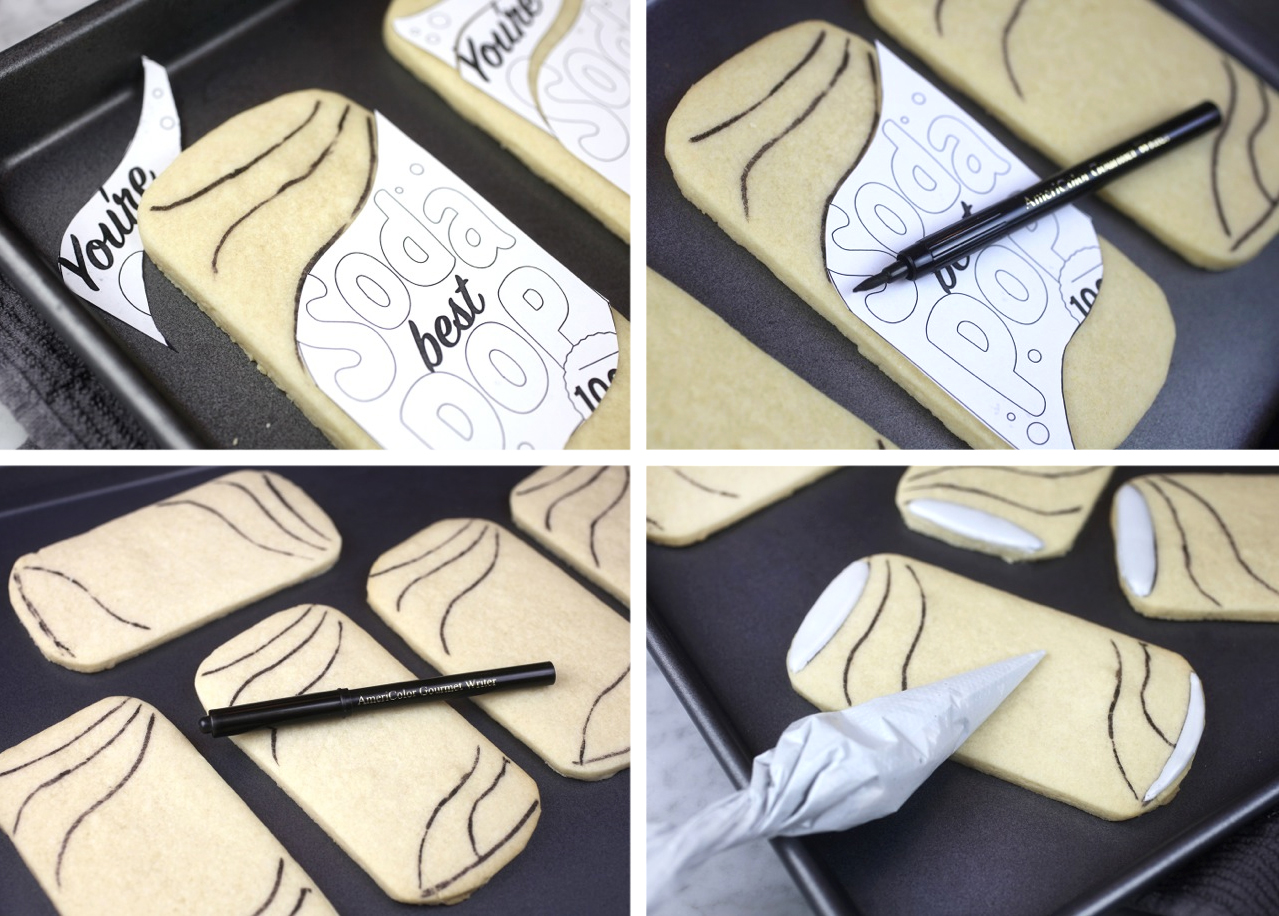
Now for the next step. I used the same template and cut it into sections to use as a piping guide. Just trace each section on the cookie with a black edible ink pen. This was super helpful for me because there is no way I could have gotten them all to look similar without it.
Now, you’ll need some royal icing. You can use the same recipe from here.

I left some of the icing white, tinted some gray and then tinted three shades of green to get started. If you’re careful and good at cookie icing planning, you can get all the colors you need out of one batch of icing.
These cookies really need to be made over two days, so you can also just make a second batch for the remaining colors when you’re ready …especially if you’re like me and not good at judging how much of each color you’ll need.
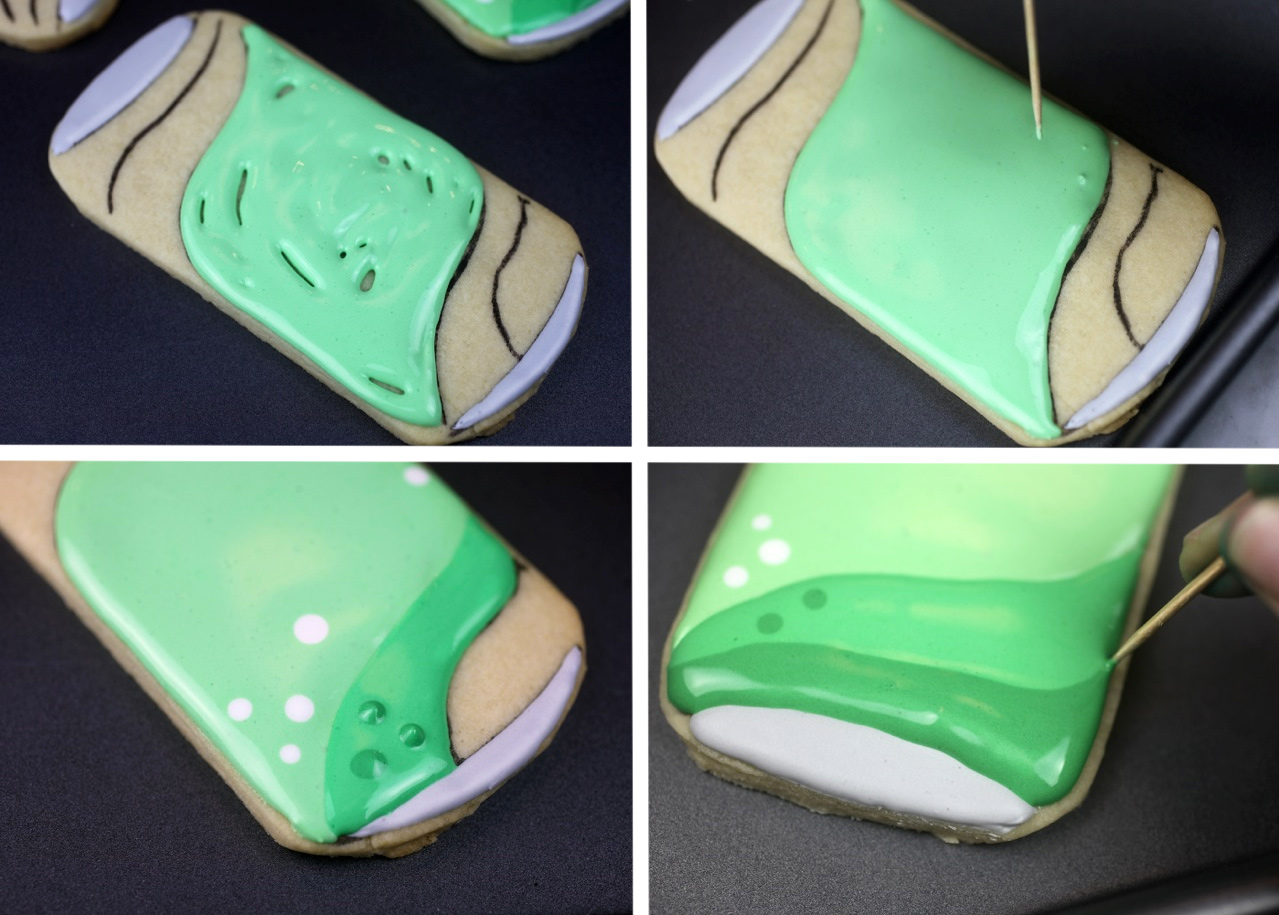
Here’s my piping order. (And I basically just played around with icing consistencies to avoid having to pipe the outlines and then come back and fill in with flood icing. To thin icing, you can add a little water and to thicken it, you can add a little powdered sugar.)
Okay, first I piped the lid and bottom of the can using tinted gray royal icing.
Then, with all my green shades ready to go, I started with the lightest color green in the middle of the can and then filled in the medium green on either side of the light green while the icing was still wet to give it a seamless look. And I repeated the same thing with the darkest shade of green. (Note: As I completed each section, I added a few dots with alternating shades before moving on to the next shade of green.)
Toothpicks are super handy. I used them to even out the icing where there were empty spaces and also to help create pointed ends. Just gently pull it through the icing as shown in the last picture above.
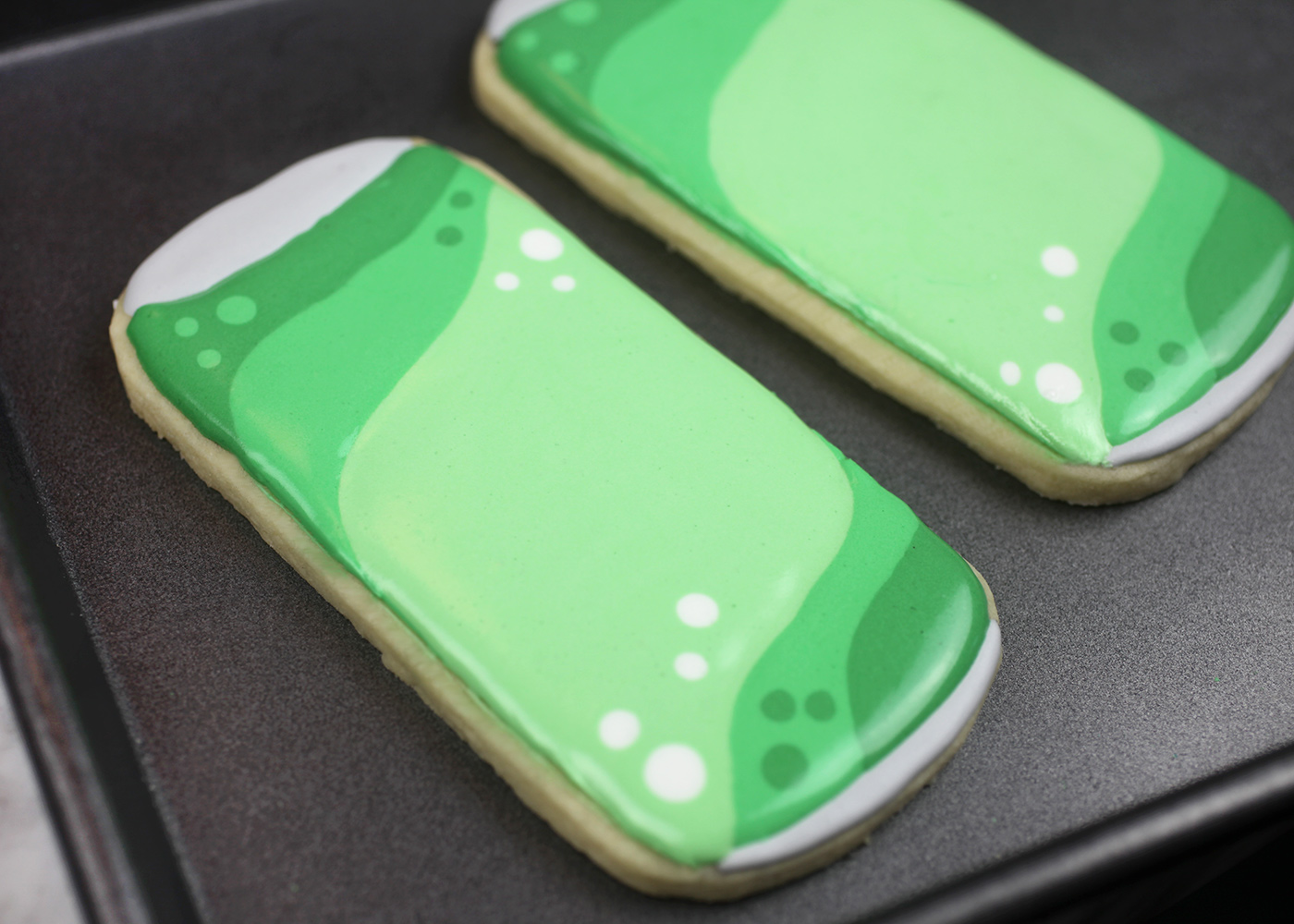
Now let dry. Dry. Dry. Dry. I would recommend drying overnight.

Now, we’re on to day two.
I used white icing and tinted blue, yellow icing and more gray icing to finish the cans.
For the words, I used the same template and cut out the word soda as one piece and the word pop with the circle badge as a second piece.
Then I could easily place each word in position and trace right on top of the cookie with an edible ink-writing pen. I used Sweet Sugarbelle’s pens here because they have a really thin tip.
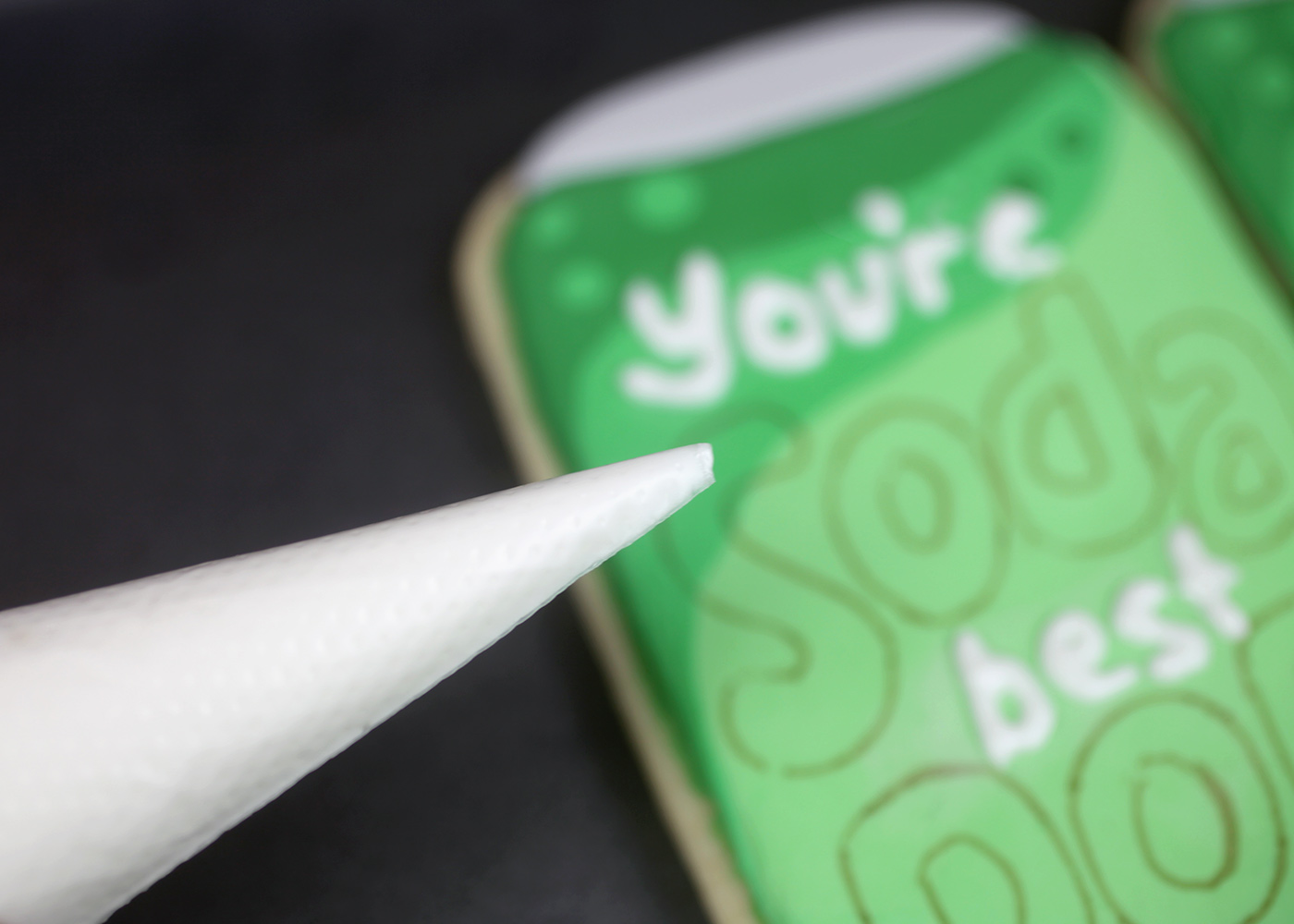
You’re best … I tried to do mine to pipe these words around the other letters.
Oh and I used tipless decorating bags to pipe everything by the way. They’re pretty handy. But me and lettering… not so much. I’m definitely not great at this. But when I would mess up, I would just wipe the icing off and start over until I got something that was readable. Let the words dry some and then you’re on to the the big letters…
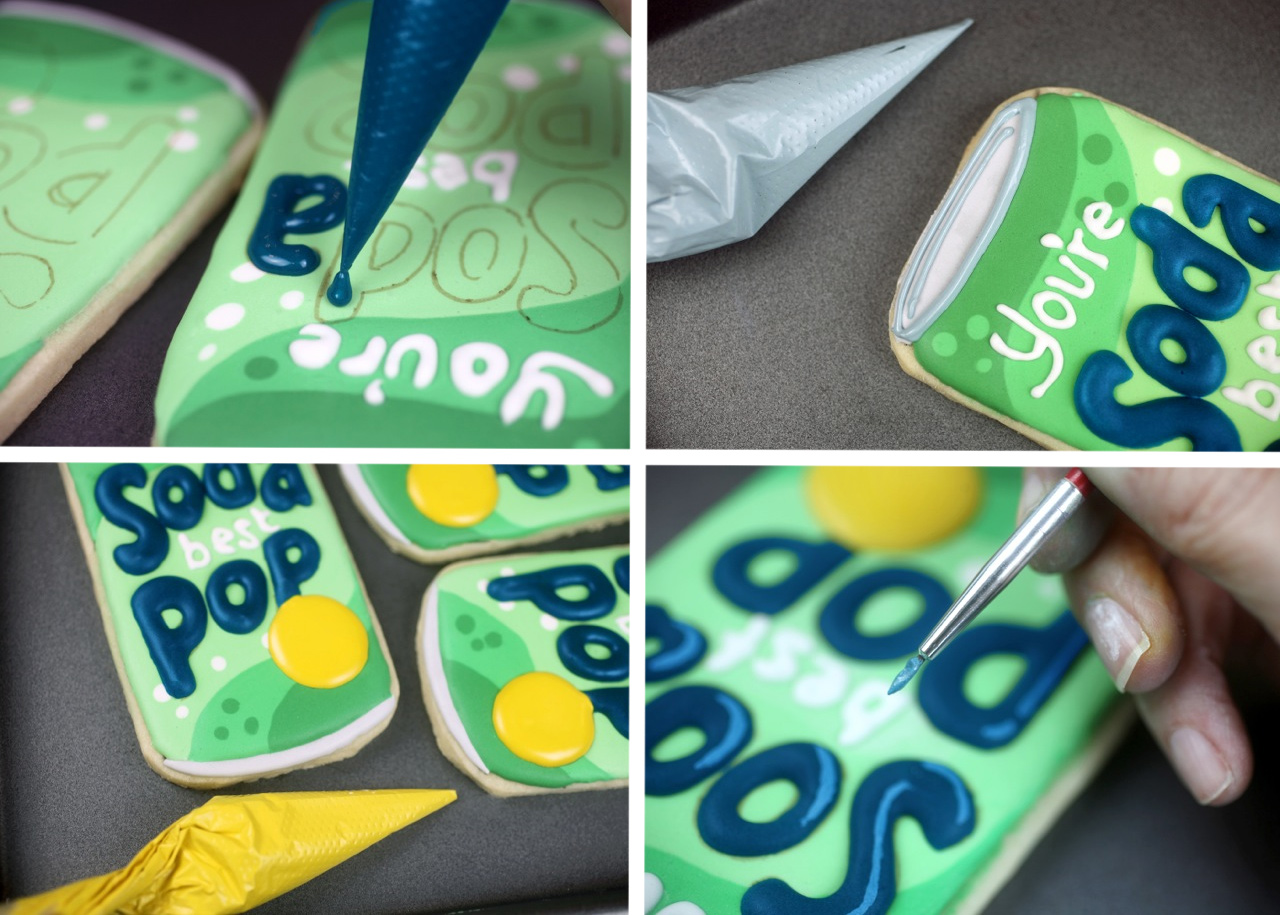
Soda Pop!
I made the blue icing with a thicker consistency so it would not spread, but would also not need to be outlined. Because that would have been a disaster.
Pipe inside the lines and then tint some icing yellow and pipe inside the circle. Outline the lid with more gray royal icing and let everything dry.
When dry, I added a little highlight detail to the big letters by lightening the remaining blue royal icing with white icing color and using a small paintbrush to gently paint highlights on the letters.

For the final touch I used an orange edible ink-writing pen to write inside the circles because after piping the white letters I knew I wouldn’t be able to make them look straight enough. The pens are much easier to control and you could even use them for the other small words if you want. Here’s the color assortment for reference.
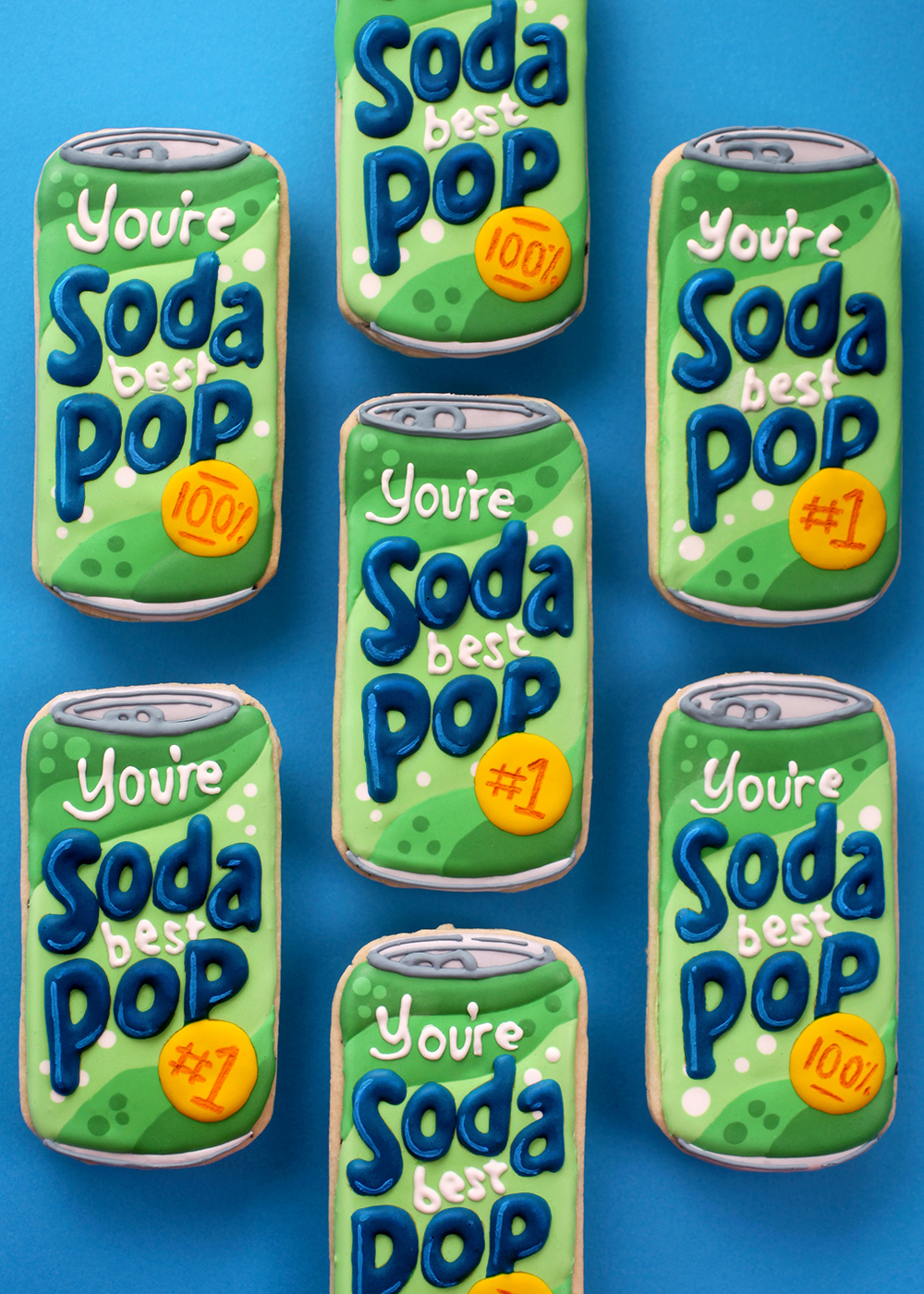
You’re so da best Pop!!! Enjoy and Happy Father’s Day to all the dads out there!
from bakerella.com https://ift.tt/2JFT9uH
Monday, June 11, 2018
The Perils Of Pushing Kids Too Hard, And How Parents Can Learn To Back Off
On New Year’s Eve, back in 2012, Savannah Eason retreated into her bedroom and picked up a pair of scissors.
“I was holding them up to my palm as if to cut myself,” she says. “Clearly what was happening was I needed someone to do something.”
Her dad managed to wrestle the scissors from her hands, but that night it had become clear she needed help.
“It was really scary,” she recalls. “I was sobbing the whole time.”
Savannah was in high school at the time. She says the pressure she felt to succeed — to aim high — had left her anxious and depressed.
“The thoughts that would go through my head were ‘this would be so much easier if I wasn’t alive, and I just didn’t have to do anything anymore.’ ”
Looking back Savannah, now 23, says the pressure started early.
She told us her story as we sat at the kitchen table of her childhood home in Wilton, Conn., a wealthy community near New York. Her dad commutes to the city where he works in finance.
From the outside, Savannah’s life may have appeared picture-perfect: two well-educated, loving parents; a beautiful home; siblings and lots of friends.
From an early age, Savannah says, she was considered one of the smart kids, and when she arrived at Wilton High School, she was surrounded by many other high achievers. Lots of kids take a heavy load of Advanced Placement and honors courses. They play varsity or club sports and are involved in lots of extracurricular activities.
But by sophomore year, the high expectations began to feel like a trap. Like many kids at her school – and at elite high schools across the country – she felt compelled to push herself to get good grades and get into a top college.
“Even though I was getting A’s and B’s, mostly A’s, in all my classes — all my honors classes — I still felt it wasn’t good enough,” Savannah says.
No matter how well she did, someone else was doing better. “The pressure I put on myself was out of control,” she says. She says she felt the pressure all around her — from peers, teachers and her parents.
Newfound awareness of these kinds of struggles, has started a conversation — and new initiatives — in her community. A group of parents is trying to shift the culture to balance the focus on achievement with an emphasis on well-being. Part of the equation is freeing up kids to find their own motivation and life path. There is a growing body of evidence pointing to elevated risks of anxiety, depression, and drug and alcohol use among kids raised in privileged communities.
A wake-up call
Savannah’s mother, Genevieve Eason, feels she was partly to blame for the pressure Savannah felt.
“I know I was talking to her by eighth grade,” Genevieve recalls, “about how she needed to find out what her passions were, so she could get involved in the right activities … so that would look good on her college applications.”
But after Savannah’s problems began, Genevieve says, she backed off. She helped Savannah drop some of her tougher courses. And the family started to focus on well-being.
“Up to that point, I totally bought into the idea we’re supposed to push our kids to achieve. When they encounter obstacles, we push [them] to overcome those,” Genevieve says. But pushing too hard can backfire.
Given the pressure-cooker environment in her community, Genevieve wondered how many other teens may also be struggling.
In order to find out, she got together with some other parents and counselors — and worked with Wilton High School to do something very unusual. They hired a psychologist to come in and assess the student body.
On the day we visited, the seniors were preparing for graduation. In the main hallway, there was a bulletin board on which students have each pinned the logo of the college they plan to attend. We saw Dartmouth, Yale, Vanderbilt, Harvard — and many other highly selective universities.
Clearly, many kids here excel. But the results of the mental health assessment showed that a lot of kids struggle, too.
“The survey results definitely suggested that Wilton High School’s rates of anxiety and depression with students was higher than national averages — significantly higher,” says school principal Robert O’Donnell. He says he was surprised and concerned.
About 1,200 students — almost the entire student body — took the survey, known as the Youth Self-Report. The survey found that compared with a national norm of 7 percent, about 30 percent of Wilton High School students had above average levels of internalizing symptoms. These include feelings of sadness, anxiety and depression. It also includes physical problems that can be linked to emotional distress such as headaches or stomachaches. Often, kids may hide these feelings.
The survey also found that rates of alcohol and drug use among Wilton students were higher than average, too. We asked the psychologist who did the assessment whether she was surprised by what she found.
“This is by no means unique to Wilton. It’s a common phenomenon across high-achieving schools,” says Suniya Luthar, professor emerita at Columbia University’s Teachers College and founder of Authentic Connections, a nonprofit that aims to build resilience in communities and schools.
Luthar has been studying adolescents for more than 20 years. She has published several studies that document the elevated rates of drug and alcohol use by kids who grow up in privileged communities — where incomes and expectations are high. Surprisingly, she says, the rates rival what she has documented in low-income, urban schools.
“What we’ve found is that kids in high-achieving, relatively affluent communities are reporting higher levels of substance use than inner-city kids and levels of anxiety and depressive symptoms are also commensurate — if not greater,” Luthar says.
Her most recent study, funded by the National Institutes of Health, found that rates of substance abuse remain high among upper-middle-class kids, as they enter early adulthood. The alcohol or drugs are a form of self-medication.
Savannah’s mother, Genevieve Eason, says she is not surprised by Luthar’s findings.
“People choose communities like this to give their children opportunities, but it comes at a cost,” Eason says.
The survey findings have been a wake-up call for the community of Wilton. “A lot of people were in denial,” says Vanessa Elias. The mother of three children is the president of the Wilton Youth Council, which aims to promote the emotional well-being of the community.
“People don’t talk about these things,” Elias says. Families often struggle silently, not realizing that their friends’ or neighbors’ kids are experiencing the same struggles. “So having an opportunity to create a conversation about this was really important,” she says.
Dialing back the pressure
The community has lots of ideas about how to tackle these issues.
The high school is focused on continuing to train counselors, and student-directed initiatives are aimed at raising awareness about anxiety and depression.
Wilton is also offering a resilience training program — GoZen! — to elementary school students. It’s a research-based program that teaches coping and happiness skills. There’s a body of evidence to show that resilience training can help reduce symptoms of depressive or negative thinking among children.
At home, Elias says, she has tried to create a low-stress environment for her children. For instance, she limits the number of after-school activities her kids participate in so they don’t spend every afternoon being driven around, overscheduled. She also limits homework time in the evening for her youngest daughter — a third-grader. As a result, “there’s a lot less friction in the household,” she says.
And when she realized that the focus on standardized testing was making one of her daughters anxious in first grade — and giving her stomachaches — she opted her two youngest children out of standardized testing.
Elias says she has been influenced by the book How To Raise An Adult by Julie Lythcott-Haims, which aims to help parents break free of what the author dubs the “over-parenting trap.”
But to really change things — to dial back the focus on academic achievement at all costs — will require a culture shift, says Eason.
“We have to broaden our definitions of success and celebrate more kinds of success,” she says.
For Eason’s daughter, Savannah, this means forging a new path.
“I don’t want to work on Wall Street; that sounds miserable to me,” Savannah says.
She enrolled in culinary school, and she is training to be a pastry chef.
“I’m never going to live the same lifestyle I did growing up,” Savannah says, “I’m not going to make that much money, but that’s OK.”
She has her own set of priorities. “It’s not about how big your house is and what kind of car you drive. It’s about happiness and peace.”
This is a different kind of success, one that her parents are now celebrating with her.
“I spend hours making a cake, and my favorite part is when you cut it up and people eat it,” Savannah says. “That’s the part when you bring joy to people, and that’s what’s important to me now.”
9(MDAxOTAwOTE4MDEyMTkxMDAzNjczZDljZA004))
from MindShift https://ift.tt/2xXEoyu